市场资讯及洞察

Most traders understand EA portfolio balance through the lens of traditional risk management — controlling position sizes, diversifying currency pairs, or limiting exposure per trade.
But in automated trading, balance is about deliberately constructing a portfolio where different strategies complement each other, measuring their collective performance, and actively managing the mix based on those measurements.
The goal is to create a “book” of EAs that can help diversify performance over time, even when individual strategies hit rough patches.
A diversified mix of EAs across timeframes and assets can, in some cases, reduce reliance on any single strategy. This approach reduces dependency on any single EA’s performance, smooths your overall equity curve, and builds resilience across changing market conditions.
It’s about running the right mix, identifying gaps in your coverage, and viewing your automated trading operation as an integrated whole rather than a collection of independent systems.
Basic Evaluation Metrics – Your Start Point
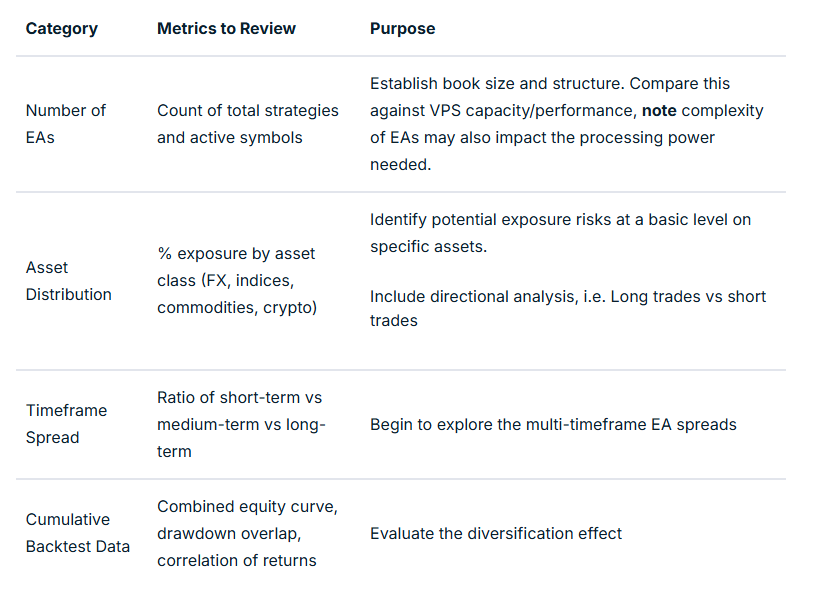
Temporal (timeframe) Balancing
When combined, a timeframe balance (even on the same model and instrument) can help flatten equity swings.
For example, a losing phase in a fast-acting M15 EA can often coincide with a profitable run in an H4 trend model.
Combining this with some market regime and sessional analysis can be beneficial.
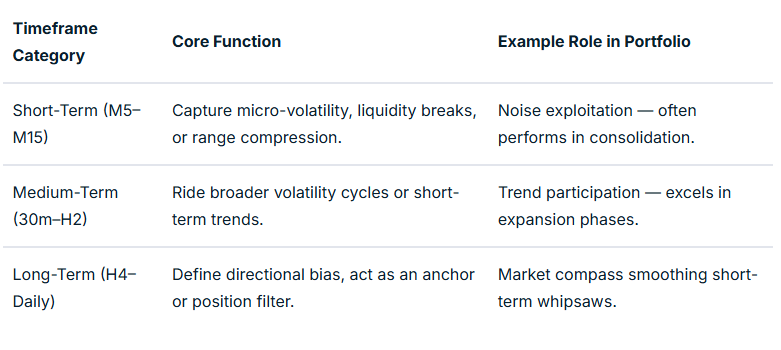
Asset Balance: Managing Systemic Correlation Risk
Running five different EAs on USDJPY might feel diversified if each uses different entry logic, even though they share the same systemic market driver.
But in an EA context, correlation measurement is not necessarily between prices, but between EA returns (equity changes) relating to specific strategies in specific market conditions.
Two EAs on the same symbol might use completely different logic and thus have near-zero correlation.
Conversely, two EAs on a different symbol may feel as though they should offer some balance, but if highly correlated in specific market conditions may not achieve your balancing aim.
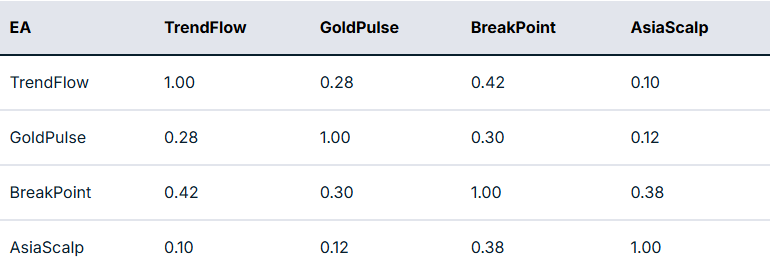
In practical terms, the next step is to take this measurement and map it to potential actionable interventions.
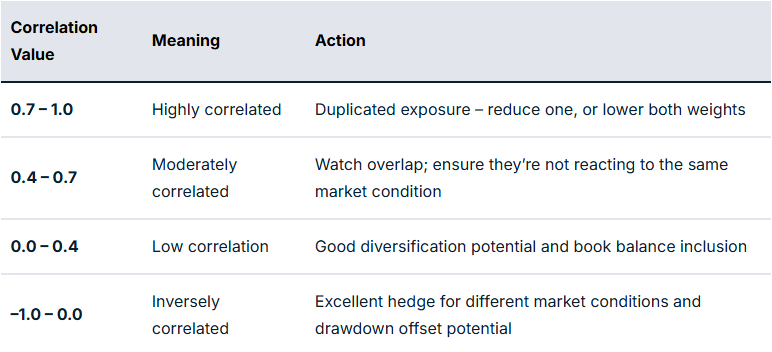
For example, if you have a EURUSD Trend EA and a GBPUSD Breakout EA with a correlation of 0.85, they are behaving like twins in performance related to specific market circumstances. And so you may want to limit exposure to some degree if you are finding that there are many relationships like this.
However, if your gold mean reversion EA correlates 0.25 compared to the rest of your book, this may offer some balance through reducing portfolio drawdown overlap.
Directional and Sentiment Balance
Markets are commonly described as risk-on or risk-off. This bias at any particular time is very likely to impact EA performance, dependent on how well balanced you are to deal with each scenario.
You may have heard the old market cliché of “up the staircase and down the elevator shaft” to describe how prices may move in alternative directions. It does appear that optimisation for each direction, rather than EAs that trade long and short, may offer better outcomes as two separate EAs rather than one catch-all.
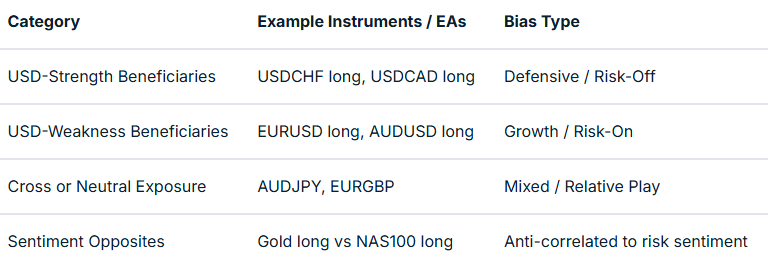
Market Regime and Volatility Balance
Trend and volatility states can have a profound impact on price action, whether as part of a discretionary or EA trading system. Much of this has a direct relationship to time of day, including the nature of individual sessions.
We have a market regime filter that incorporates trend and volatility factors in many EAs to account for this. This can be mapped and tested on a backtest and in a live environment to give evidence of strategy suitability for specific market conditions.
For example, mean reversion strategies may work well in the Asian session but less so in strongly trending markets and the higher volatility of the early part of the US session.
As part of balancing, you are asking questions as to whether you actually have EA strategies suited to different market regimes in place, or are you using these together to optimise book performance?
The table below summarises such an approach of regime vs market mapping:
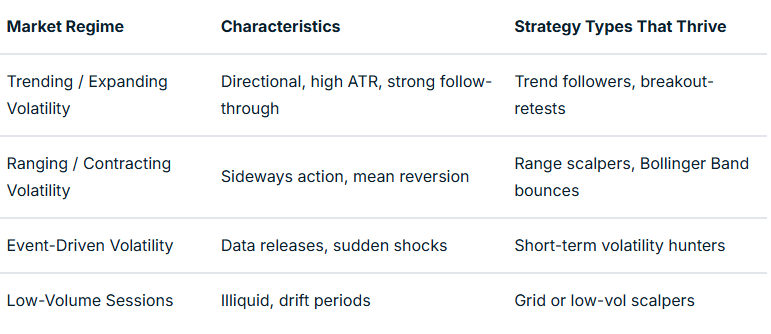
Multi-Level Analysis: From Composition to Interaction
Once your book is structured, the challenge is to turn it into something workable. An additional layer of refinement that turns theory and measurement into something meaningful in action is where any difference will be made.
This “closing the circle” is based on evidence and a true understanding of how your EAs are behaving together. It is the step that takes you to the point where automation can begin to move to the next level.
Mapping relationships with robust and detailed performance evaluation will take time to provide evidence that these are actually making a difference in meeting balancing aims.
To really excel, you should have systems in place that allow ongoing evaluation of the approaches you are using and advise of refinements that may improve things over time.
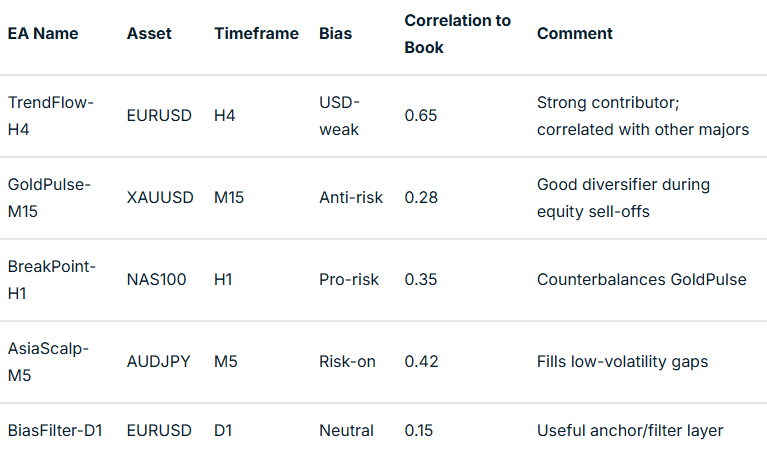
What Next? – Implementing Balance in Practice
Theory must ultimately translate into an executable EA book. A plan of action with landmarks to show progress and maintain motivation is crucial in this approach.
Defining classification tags, setting risk weights, and building monitoring dashboards are all worth consideration.
Advanced EA traders could also consider a supervisory ‘Sentinel’ EA, or ‘mothership’ approach, to enable or disable EAs dynamically based on underlying market metrics and external information integrated into EA coding decision-making.
Final Thoughts
A balanced EA portfolio is not generated by accident; it is well-thought-out, evidence-based and a continuously developing architecture. It is designed to offer improved risk management across your EA portfolio and improved trading outcomes.
Your process begins with mapping your existing strategies by number, asset, and timeframe, then expands into analysing correlations, directional bias, and volatility regimes.
When you reach the stage where one EA’s drawdown is another’s opportunity, you are no longer simply trading models but managing a system of EA systems. To finish, ask yourself the question, “Could this approach contribute to improved outcomes over time?”. If your answer is “yes,” then your mission is clear.
If you are interested in learning more about adding EAs to your trading toolbox, join the new GO EA Programme (coming soon) by contacting [email protected].


美股周一高开低走,最终三大指数涨跌不一,标普和纳指微幅收涨,道指小幅下挫。市场对本周将公布的经济数据与贸易政策走向保持高度敏感情绪。虽然欧美方面达成部分关税协议,但并未有效带动市场情绪上行,投资者显然更关注后续执行与实际落地情况。在对外政策上,有关关税、朝核、能源等多重议题仍在发酵。市场当前聚焦特朗普提出的全球关税参考区间(15%-20%)及中美新一轮沟通动向。同时,美国对外政策立场趋强,地缘因素对风险资产的压制作用依旧存在。在板块表现上,美股走势分化明显。AI概念持续升温,受AI大会推动,超微电脑单日上涨超10%,英伟达再度创出新高,特斯拉与AMD也延续反弹走势。相对而言,核能板块全线回调,前期强势的电力供应类股仅维持小幅波动。数字货币概念仍处于整理阶段,受短期利空与估值调整影响,相关个股延续上周弱势。不过市场情绪有望在后半周得到修复——以太坊基金会将于月底举办成立10周年庆典,美国也将首次发布数字资产政策报告,此外包括Coinbase、MSTR与Robinhood在内的财报预期普遍乐观,短线回调或为波段机会。宏观层面,美元强势回归。周一美元指数大涨逾1%,重返98平台,主要受益于本周GDP数据与相关利好预期。黄金受压,但仍企稳3300美元上方;油价显著反弹,恐慌指数小幅下滑。汇市方面,美元领涨主导本轮节奏,美日站稳148,具备进一步上行空间;澳元整体仍具韧性,兑美元稳定在0.65上方,对人民币则回落至4.68附近;美元兑人民币升破7.18,整体延续强势格局。整体来看,市场在七月最后一周进入关键观察期,投资者宜重点关注即将公布的宏观数据及科技巨头财报,同时对高估值资产保持审慎布局,等待更清晰的政策与趋势信号。免责声明:GO Markets 分析师或外部发言人提供的信息基于其独立分析或个人经验。所表达的观点或交易风格仅代表其个人;并不代表 GO Markets 的观点或立场。联系方式:墨尔本 03 8658 0603悉尼 02 9188 0418中国地区(中文) 400 120 8537中国地区(英文) +248 4 671 903作者:Xavier Zhang | GO Markets 高级分析师


The setup appears to be perfect. You convince yourself that this is the trade. You execute the order, and within minutes, what seemed like a likely winner becomes another painful lesson in market donation.This all-too-common scenario boils down to a fundamental flaw in human decision-making under pressure. When we experience strong emotions, whether from recent losses, FOMO, or overconfidence, making consistently good decisions becomes increasingly difficult.The solution is not the use of complex trading EAs or expensive analytical software, but a simple behavioural intervention. Let’s call it “The 5-Minute Rule”.
The 5-Minute Rule
The 5-Minute Rule is a tactic that acts as a cognitive “circuit breaker,” designed to interrupt potentially damaging emotional decision-making that may begin to take over from that which you had originally planned to do.Its implementation is easy. You set in stone that before entering any trade, you take your mandatory 5-minute pause away from trading platforms. When it is done, then you reassess the opportunity using predetermined criteria from your trading plan.This intervention can allow your mind to shift from a reactive state, caught up in the heat of market action, to more analytical processing.Note: If the prospect of leaving a potential opportunity for a full 5 minutes seems mad, try a shorter time (e.g., 3 minutes) – it is the principle rather than the exact number of minutes that is the key here.
The Science Behind Emotional Trading
When experiencing intense emotions, your mind has a tendency to trigger a “fight-or-flight response” that can bypass rational decision-making. This can create several cognitive distortions, which result in a trader moving away from what they have written in their plan.Here are a few of the more common cognitive distortions:
- Loss Aversion: Investors value gains and losses differently — the emotional impact from a loss is much more severe than from an equivalent gain.
- Overconfidence Bias: Overconfidence in ability can lead to emotional and reactionary trading decisions.
- Confirmation Bias: Traders seek information that supports entering a trade, while ignoring signals against it.
- Recency Bias: Recent losses feel more significant, driving decision-making more than historical data suggests.
The 5-minute pause allows your mind to regain control — restoring access to logical analysis and learned trading principles and planning.
Trading 24/5 Markets
The continuous nature of forex, commodity, crypto, and index CFD markets makes emotional discipline particularly crucial. Currency pairs often present multiple "perfect" setups throughout the day, making revenge trading after EUR/USD or GBP/JPY losses especially tempting. The 5-minute rule can be particularly valuable here as these markets typically offer sufficient liquidity, so genuine opportunities don't disappear within minutes.
Physiological Changes During Your 5-minute Pause
During primary and increasing emotional trading states, several measurable physiological changes occur that impair decision-making:
- Elevated cortisol levels potentially reduce memory formation and logical processing
- An increased heart rate decreases fine motor control and attention span
- Shallow breathing reduces oxygen flow to the brain
- Muscle tension creates physical discomfort that reinforces emotional distress
Research indicates that stress hormone levels begin stabilising and heart rate will return to your usual level within a few short minutes of removing acute stressors, and put you back in a potentially improved decision-making state.
Making Your 5-Minute Rule happen
The key to putting this into practice is self-awareness of your trading state. Asking yourself if any of the following are where you are now as you watch price action on the screen:
- Revenge Trading Psychology: The urge to "get even" with the market after a series of losses
- FOMO-Driven Urgency: Fear that missing immediate entry means missing the entire opportunity of a potential price mover
- Overconfidence: Desire to increase position sizes (and so risk) after winning streaks
- Frustration-Based Forcing trades: Attempting to create opportunities when none exist
- News-Reaction Trading: Impulsive responses to rapid market-moving prices after information release
Systematic Stages
There are four initial stages to managing this situation:
- Recognition Stage: Identify your current emotional state through self-monitoring.
- Acceptance stage: Accept that your urge for action may not be consistent with the plan, and it is okay to NOT take immediate action.
- Separation Phase: During your allotted distance minutes, you should be focused on calm breathing and light movement, or perhaps engage in something unrelated to trading.
- Reassessment Phase: Return to your screen and evaluate the opportunity using your predetermined criteria.
Post-Pause Evaluation Criteria
After your pause is completed, you should re-assess the opportunity against specific questions:
- Does this trade entry match my written trading rules?
- Is the position size I intend to take appropriate for my tolerable risk level?
- Do chart patterns and indicators support my trading idea?
- Does the potential profit justify the potential risk of loss?
- How does this trade fit within broader market conditions?
Measuring the Success of Your 5-Minute Rule
As with any intervention within your trading, it is critical to objectively measure its success. This provides evidence as to whether it works and gives some motivation to continue implementing it — even in the toughest trading situations.Track specific measurements to evaluate the rule's effectiveness on your key trading metrics:
- Win Rate Changes: Percentage of profitable trades before and after implementation
- Average Loss Size: Maximum risk per trade and drawdown periods
- Trade Frequency: Number of trades per time period
Also monitor subjective improvements in your overall trading experience:
- Stress Levels: Daily emotional state ratings both during and after trading
- Sleep Quality: Rest patterns on trading days
- Confidence: Self-assessed decision-making certainty. E.g., confidence in your plan.
The Compounding Effect of Emotional Control
The 5-Minute Rule's benefits may extend beyond trading outcomes in individual trades. Each successful pause strengthens your belief in what you are doing and how you are doing it, as your emotional regulation can become easier and more automatic. Over time, you may find they need the formal pause less frequently as their default response generally shifts from being reactive to analytical, and it is only in the most extreme situations where it is needed.It is a journey that takes time to master and a number of trades to begin to see the overall positive outcomes of adopting this within your trader’s toolbox.
Final Thoughts
The 5-Minute Rule represents a practical application of behavioural science to trading performance. It may be of benefit irrespective of the type of trader you are, the markets you trade, and the level of experience you have.It is a tactic related to a recognised physiological response to stress, where short-term emotional factors may have a significant effect on decision-making.Markets will always present opportunities, but emotional discipline to follow through on your plan is likely to help with long-term success. Think of it this way: if it makes no difference to your outcomes, then you have lost nothing, but if these 5 minutes of patience can place you in a better trading state, then mastering this could prevent years of potentially negative outcomes.
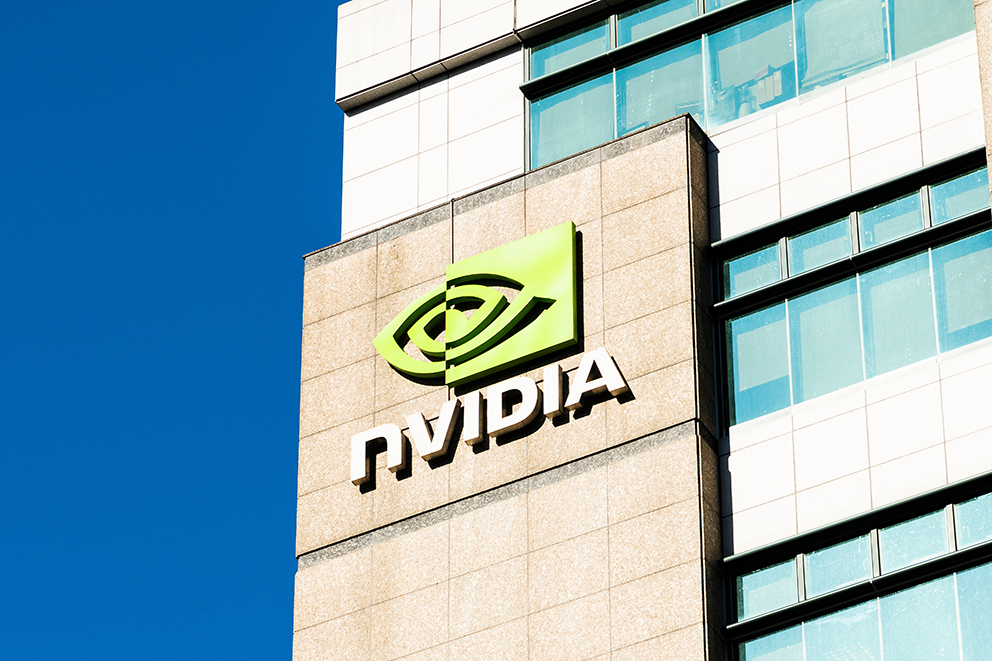

Most people think Nvidia got lucky with AI. They made chips that were good for gaming, and it turned out those same chips were good for machine learning.But that's not what happened at all…What actually happened reveals a fundamental misunderstanding of technology markets, and why investors often misread them.
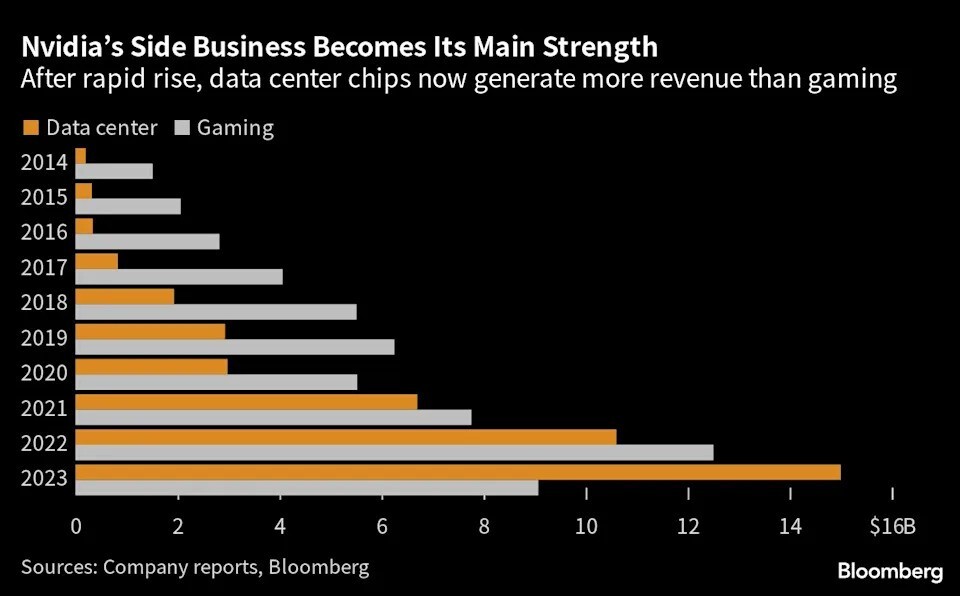
Nvidia’s data center revenue flipped gaming in 2023
Why Markets Misread Platform Plays
Markets consistently undervalue platform investments while they're being made, then overvalue them once they succeed. Platform plays often appear to be terrible business decisions for years before they become obviously valuable.CUDA — Nvidia's software platform that made it possible to harness graphics card compute power for general-purpose usage — is the perfect example of this.When Nvidia was spending heavily on CUDA in the mid-2000s, the market saw it as an expensive distraction from its core graphics business.The investment made no sense. They were giving away free software to sell hardware, in an industry where hardware margins were already under pressure.Markets tend to price such technology investments through the lens of existing applications rather than potential ones. They can see the current build cost but fail to factor in the potential future value.
The Economics of Platform Capture
Technology markets have the somewhat unique capacity to shift from competing products to competing ecosystems.If this shift from product to ecosystem wars occurs, traditional competitive analysis can become almost useless.In a product market, a 10% advantage might translate to a 10% market share gain. In an ecosystem market, a 10% advantage can translate to a 90% market share, due to network effects and switching costs.This is why established companies with superior resources often lose to platform challengers. AMD and Intel both had as much (or more) money and engineering talent as Nvidia during its CUDA development years. But they were competing in the wrong game. They were optimizing for product performance while Nvidia was building ecosystem lock-in.
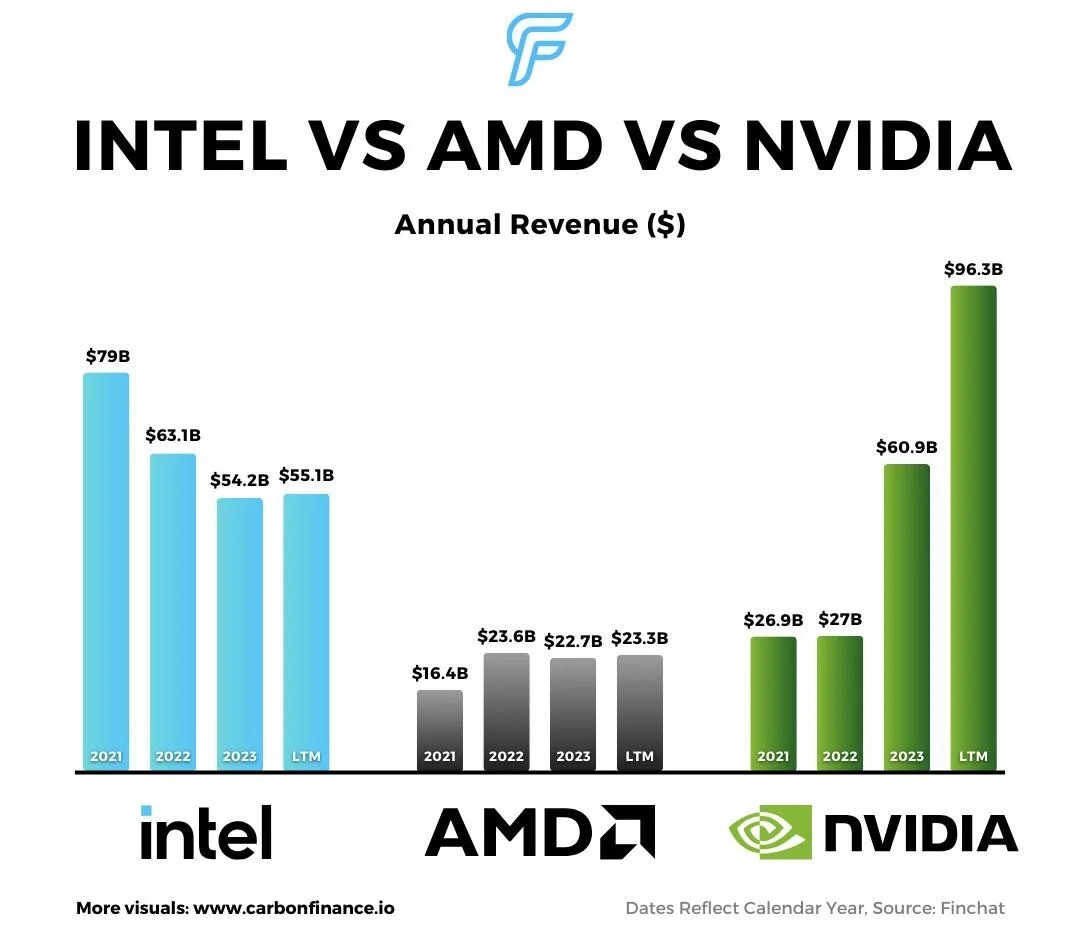
The Platform Investment Paradox
Platform investments create a paradox for public markets. The companies that make the biggest platform bets often see their stock prices suffer during the investment phase.Product investments have visible, measurable returns that markets can model. Platform investments have uncertain returns that depend on market timing and adoption patterns that are impossible to predict.This is why markets consistently undervalue platform companies during their growth phase. Traditional financial metrics capture the cost of platform investment but miss the value creation occurring in the ecosystem.By the time platform value becomes visible in financial results, the strategic opportunity has usually already passed. The companies that capture platform markets are typically those that invest before the value is measurable, not after it becomes obvious.
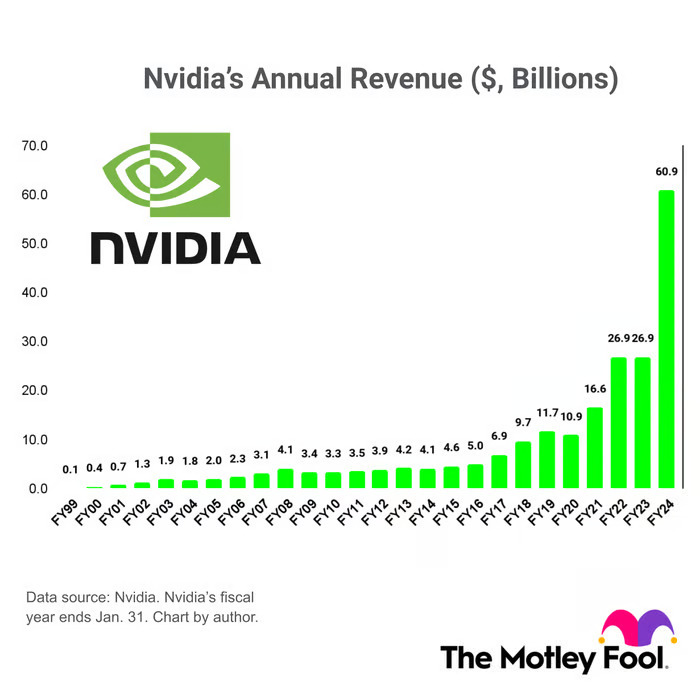
Nvidia’s 25-year Annual revenue growth - image by Motley Fool
Ecosystem Network Effect
Every developer who learns CUDA makes the Nvidia ecosystem more valuable. Every model trained on Nvidia infrastructure increases switching costs for the entire AI market.Gaining a competitive advantage in platform markets is more about ecosystem momentum than building superior products. The platform that attracts the most developers and creates the most applications becomes increasingly difficult to displace.Markets often misinterpret this momentum as a temporary competitive advantage rather than recognizing it as a structural shift in the market. They keep expecting "competition" to erode platform dominance, not realizing that successful platforms tend to make competition irrelevant.
What This Means for Market Analysis
The Nvidia pattern suggests that technology market analysis needs to focus more on ecosystem dynamics and less on product comparisons. The companies that will dominate the next wave of technology markets are likely building platforms today for applications that don't yet exist at scale.This requires looking beyond current revenue and margins to understand what infrastructure is being built for the future. The most important question isn't whether a company has the best current product, but whether they're creating the ecosystem that future applications will be built on.Of course, such companies are unlikely to achieve the heights of Nvidia, but the ones that find success will likely follow the same pattern — years of patient platform building followed by explosive ecosystem capture when the market inflection point arrives.Trade Nvidia and thousands of other Share CFDs on GO Markets — starting from just US$0.02 per share with no monthly data fee.
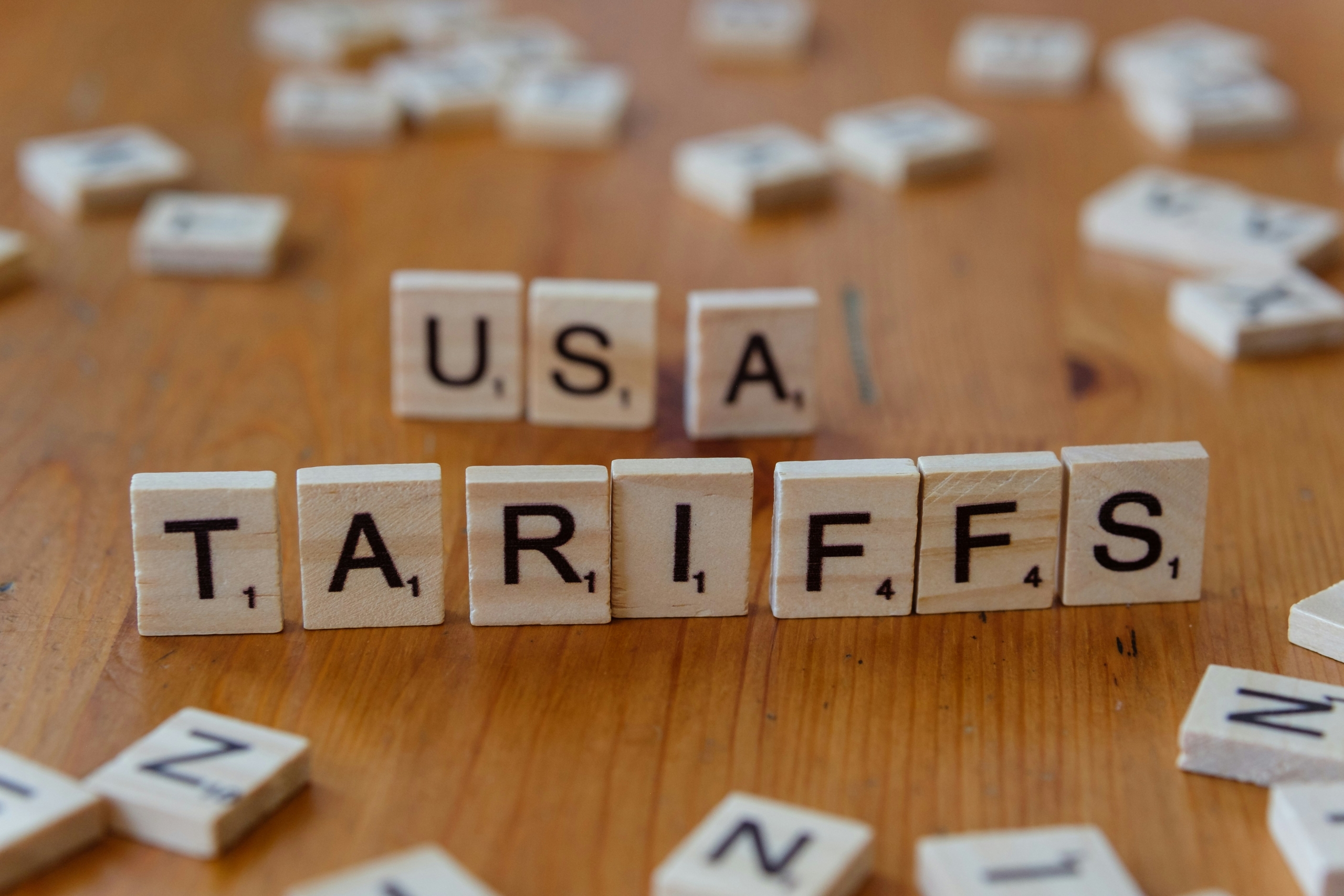

刚刚过去的周末,为全球市场带来了一记“定心丸”——欧美如期达成关税协议,欧盟做出妥协,接受15%的美方关税并承诺加大对美投资,至此,原本影响八月市场走势的不确定性大大缓解。当前,随着日本和欧盟的谈判取得进展,美国的全球贸易策略正逐步落地,其关税布局已完成主要环节。8月1日原定的关税调整窗口期临近,而目前市场普遍认为,即便届时个别谈判未能达成协议,美国也将按原计划执行相应税率,预计这类政策变化对整体市场影响已被充分计价。对于投资者而言,贸易风险暂时出清,意味着上半周市场情绪将维持相对稳定,资金面依旧积极。不过,本周依然是名副其实的“重磅数据周”。不仅迎来美联储利率决议、非农就业报告、核心PCE等关键经济指标,还将有多家科技与金融巨头发布财报,加之“稳定币监管法案”“大而美基础设施法案”等政策密集出台,市场后半段的波动将明显加剧。从趋势上看,上周标普和纳指继续刷新高点,即使个别财报表现平平,也并未削弱多头信心。本周非农数据若符合预期,反而可能进一步强化降息预期;而GDP数据若出现反弹,则将为美元提供新的支撑动力。目前市场已普遍接受短期内不降息的可能,美联储动向更可能影响未来利率路径的节奏,而非方向。大宗商品方面,美元预期上行使得黄金价格或面临阶段性回调压力;恐慌指数预计继续走低,油价短期将继续围绕目标价区间波动。汇市方面,非美货币预计持续承压,人民币及澳元兑美元存在一定回调风险,建议投资者留意本周后半段的市场节奏变化,提前做好防御性配置。联系方式:墨尔本 03 8658 0603悉尼 02 9188 0418中国地区(中文) 400 120 8537中国地区(英文) +248 4 671 903作者:Xavier Zhang | GO Markets 高级分析师


说起AI应用,我们最耳熟能详的无非是Chat GPT 和Google的Gemini,但是Meta也值得我们关注,它的Llama正在飞速追赶。那Meta能否再创Facebook的辉煌,在AI的盘子上分得一块大蛋糕呢?今天我们来拆解一下。2021年当时比较火的概念是虚拟世界,Facebook的广告业务面临时代变革,而后Facebook改名为Meta,Meta就是元宇宙的简称,可以看出扎克伯格是个勇于追赶时代步伐的改革派,当然虚拟世界最后不了了之,但有这种不甘落后的指挥官,Meta定不会被科技进步抛弃。再看现在的AI,Meta比OpenAI和Google起步晚了六年,而就当前AI 模型整体能力来看,Meta 的 Llama 4 系列相较于 OpenAI 的 GPT-4o 和 Google 的 Gemini 1.5 Pro,大概落后了两年。起步晚不要紧,知道加速追才是最重要的,为此Meta直接掏出了“科技界的闪电战”策略。什么是“科技界的闪电战”呢,简单讲就是天价挖人+开源。这两年Meta心想:“不行了,这AI圈我不能输!” 然后掏出支票本开始疯狂砸钱,把硅谷顶尖公司的人才几乎挖空了一半。这波操作堪称科技界的“钞能力大战”,被挖的大神们,拿着数千万甚至上亿美元的签约费,纷纷从OpenAI、Google、Apple这些大佬家“集体跑路”,奔向Meta怀抱。有人调侃:“Meta这哪是招人啊,简直是人手一本天价支票的抢人大赛!” 就这样,Meta迅速凑出了一支从语音聊天到视觉识别,从写代码到架构模型,连开源代码和端侧部署都一锅炖的大杂烩超级AI军团。这场挖角大戏还没播完,OpenAI和Google就已经哭晕在厕所门口了。而扎克伯格则在办公室里一边刷着员工入职通知,一边微笑表示:“有钱就是任性,我不是针对谁,我是说在座的各位AI公司,全都是弟弟。”。

而且OpenAI、Google 在模型上越来越保守封闭,就是怕别人抄他们的代码,而 Meta 反其道而行之,利用开源在技术社区形成口碑优势:“我们 Meta 不玩锁喉战术,大家都能上车。” 看起来是道德高地,收益满满。开源相当于 Meta 不用花一分钱工资,就多出了成千上万个“免费劳动力”,每天帮它优化模型、修Bug、写插件,成本远低于 OpenAI 和 Google 动辄几百亿美元的投入。这套战术打出来,Meta不和OpenAI、Google卷闭源赛道,舒舒服服做开源老大。开源闭源战法在很多行业都有例子,像手机操作系统的苹果和安卓,显卡领域的英伟达和AMD,后者不如前者起步早技术先进,但是利用开源的策略始终落后不了太多。而且Meta挖来了这么多AI人才,再利用自己开源下的追赶进度,直接推出一个高级闭源模型,形成开源(Llama)+闭源(Meta AI)组合拳,直接就有了正面硬刚OpenAI、Google的实力。总结:当前是个科技大爆发的时代,AI的浪潮中你方唱罢我登场,我们不能只紧盯行业龙头的那几个企业,也要看看龙头后面的追赶者,众多追赶者中总有一匹黑马值得我们青睐。Meta就算最后没能在大语言模型上赶超成功,它的这种不甘落后、绞尽脑汁追赶的态度,也能让它在AI这块蛋糕上啃下大大一口。免责声明:GO Markets 分析师或外部发言人提供的信息基于其独立分析或个人经验。所表达的观点或交易风格仅代表其个人;并不代表 GO Markets 的观点或立场。联系方式:墨尔本 03 8658 0603悉尼 02 9188 0418中国地区(中文) 400 120 8537中国地区(英文) +248 4 671 903作者:Mill Li | GO Markets 墨尔本中文部


Few traders would suggest that effective risk management is highly critical to ongoing trading success. But there remains an ongoing debate about the optimal risk management method to use, and whether a system stop loss is something that is needed at all. There are a lot of traders who remain unconfident about what is best for their individual trading style. If you get it wrong, the likely scenarios are either you are stopped out too early by market noise only to see price subsequently move in your desired direction, or that placement means that you take a larger loss than planned. This is especially true in leveraged trading, where even small moves can have a significant impact. The potential for a catastrophic candle subsequent to a black swan event or even a sudden unplanned news item coming across the wires can do major damage to your account balance if you are not effectively protected.
Do You Need a Stop at All?
There are traders who argue against hard stops, preferring mental stops or flexible exits based on evolving price action. On the surface, this can sound appealing as it is price action that invariably dictates entry, so using the same logic for exit appears to be congruent.
What does this mean in reality?
The emotional pressure of not having a safety net can be significant and may shift during the life of a trade, particularly when a trade is not moving in your desired direction. The challenge of discipline in execution is difficult enough when a trade has moved into profit, but if you are in a losing position, this is amplifiedA catastrophic candle can occur at any time. Even if many events are predictable, some are not. A terrorist attack, a major environmental event, or a change in government policy can send prices spiralling in a heartbeat. Unless you are prepared to take on this risk, you need to be in front of a computer screen at all times. Even then, price movement may be exceedingly quick, causing major losses before you have a chance to take action.
Why Standard Stop Methods Often Fall Short
Fixed Pip or Percentage Stops
The idea of a fixed-size stop, whether it’s 50 pips or a 1% move from entry, appeals because it’s simple and clear-cut.However, markets don’t move in uniform increments. A 20-pip move on EURUSD might be normal activity in Asia on an hourly chart, but can be significantly different at the start of the European session.On the AUDNZD, a 1% move in price could take several hours to happen, but on a gold trade, it could happen in minutes.These stops lack sensitivity to volatility, timeframe, and market context. They may work on a single instrument in a single timeframe, but are likely not transferable to any other context.
The Problem with Round Numbers
The human mind is automatically drawn to round numbers.Traders often cluster buy and sell pending orders and stop orders around these levels, creating self-fulfilling reaction points for the market.If you have identified that your desired stop is near a round number, consider the “spacing” option, perhaps a buffer of 10-20$ ATR to take it away from the wicks we often see around these levels as stops are taken out. For example, if ATR is 30 pips and price is at a round number, consider setting your stop to 3-6 pips beyond the round number, giving your trade a fighting chance to survive the typical round number fake-out.
Key Level Stops
Similar to round numbers, key levels based on previous price action are logical places for prices to test and bounce, and trigger your stop.The same buffer principle described above could also be applied in this scenario. Looking at what a typical test and failure of levels in price distance on specific instruments may have some value, but this is the next level after a system is already in place, and does not account for volatility changes during a day.
The Case for the ATR Multiple Stop
The Average True Range (ATR) measures market volatility by averaging recent price ranges.When you multiply ATR by a specific factor, you create a volatility-adjusted stop that scales with the current instrument and timeframe you are trading.There are three main reasons that a multiple of ATR-based stops may overcome some of the challenges outlined earlier:
- They are flexible with and responsive to the underlying instrument character
- They provide consistency and the required automatic adjustment across instruments and on different timeframes
- They go some way to help avoid stops that are too tight in volatile markets or too loose in quiet ones
For example, on your chosen instrument, the ATR on a 15-minute chart may be 12 pips. If you were to have in your plan that stops will be placed 1.5x ATR away from the signal for entry, then you would place the stop 18 pips away.However, if you were trading a longer timeframe where the expectation is a great movement per candle, the ATR may be 20 pips; hence, your stop would be placed 30 pips away. You can then calculate the position size based on the difference between entry and stop compared with your risk tolerance. This is important not to miss; the key here is to keep risk within a tolerable limit while also making sure you are giving your trade a chance to breathe.
The ATR challenges
Let’s say that you have made the decision to explore an ATR stop further; there are additional decisions to make as to how you use this in your trading.
Challenge #1 - How Big Should Your ATR Multiple Be?
The “right” multiple depends on:
- Your trading style
- The market you trade
- Your timeframe
Here is a practical approach to get you started.
- Review your last 20 trades
- Check where your “undesirable” stops were hit. Record whether they were inside your chosen ATR multiple times. (Remember you are looking for probabilities here, not an “every time” solution.)
- Adjust and test until you find a range that minimises premature stop-outs without giving away too much profit potential.
1.5 ATR may be a good starting point to try, as this is a commonly used level by some traders.
Challenge #2 - Static ATR vs. Dynamic ATR Stops
Static ATR Stops are calculated at entry and remain fixed throughout the life of the trade, are simple, and require no adjustment.Dynamic ATR Stops are adjusted with changing volatility, which may be most relevant for trades held over multiple sessions, but does require regular monitoring.Ultimately, you need to make a choice that is right for you, and this may be a hybrid approach where there are defined times to adjust. Of course, this may be negated to a large degree, dependent on what point your initial stop begins to trail with the direction of the trade.
Challenge #3 Entry Signal Level vs. Entry Price — Where Should You Anchor Your Stop?
This is a nuance many may overlook. You need to plant your flag on how you are going to calculate your ATR-based stop. From your actual entry price, or from the signal level?Logically, the trade idea is proven to have moved against you when the reason for entry is no longer valid. However, there may be some price distance between these two levels, so one approach I have seen used is if the entry candle is more than X ATR above the signal line, then use this as your point.Again, if you need to find out what is right for you and your trading style, start with the simple first and then add the variation to see if there is a difference in outcomes.
This is Only Step One
Placing your stop is only the beginning of trade management. The next phase is knowing how and when to trail your stop so you can lock in profit as a trade moves in your direction.This is a story for another day, but worth mentioning as part of your “grand exit plan”. We have done both videos and articles on this, so it would be worth it once you have mastered this element to move on to the next.
Summary
The ATR multiple stop is one of the most adaptable and logical ways to set your initial risk level.It offers a structured way to try and avoid some of the classic stop placement pitfalls by accommodating market conditions, instrument volatility, and adaptability to the timeframe.But like any method, it has challenges that you need to be aware of in your decision-making:
- Choosing the right ATR multiple
- Deciding between static and dynamic approaches
- Aligning your stop with your entry price
All require planning, testing, and execution discipline. Your starting point is to test this out, ideally on trades you have taken previously, and incrementally build on a relatively simple approach.

